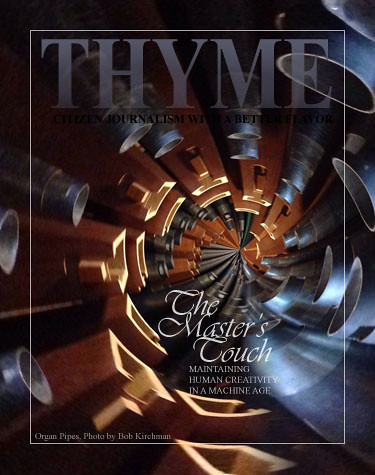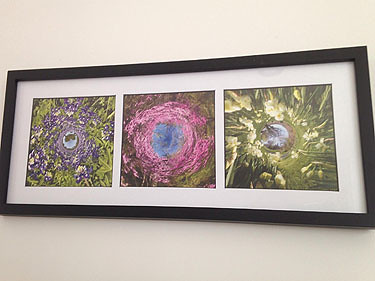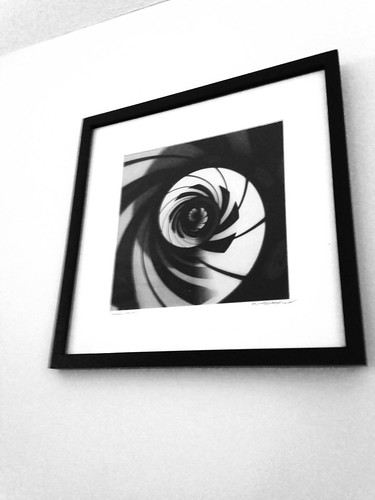
Volume IX, Issue XVIII
IMAGO DEI in Faith
and Craftsmanship
The movie "The Matrix" takes us to a dystopia where man exists solely to feed the machine. Some feel that our present world is moving headlong in that direction as machines more and more surround us, inform us, entertain us and are seemingly attached to us. More young men live alone and spend most of their non-working time playing video games. Have we lost our sense of place as a unique entity in creation? Are we in need of rescuers like Neo, Morpheus and Trinity?
I read a fascinating review of Matthew Crawford's new book--The World Beyond Your Head: On Becoming an Individual in an Age of Distraction. Crawford's Book [click to read] laments the "attentional economy" that reduces us to market guinea pigs in a world of technological stimulation. In light of last week's look at The Creative Mandate of Bezalel and Oholiab, I find Crawford's perscriptions most fascinating. He sees the answer in part in a return to the values learned in skilled practices, such as carpentry: "...the development of skilled practices allows us to navigate it in ways that ultimately focus our attention and expand our competence and agency. And since we usually learn these practices alongside others, often under the guidance of experienced teachers, they draw us into relationships with people as well as things.
To learn a skilled practice like carpentry you have to humble yourself. You must endure failure, frustration, heckling, and perhaps injury, but you end up with expertise, confidence, and objective standards for judging your work and the work of others—all of which entail a truer and more enduring individuality than today’s hollow consumerist self-fashioning. This individuality also provides a surer foundation for democracy." [1.] He also sees the meditative qualities of Faith as essential to this more patient life, out of step with the techno-masters.
Crawford takes the reader inside the organ building shop of local builders: Taylor and Boody [2.] and indeed finds a comradery of craftsmanship. Indeed there is something to be found in the 'old' craftsmanship that is sorely lacking (or so it seems) in our modern world. But consider this; until the dawn of aviation the pipe organ WAS the most sophisticated machine on the face of the Earth. No doubt the dawn of the pipe organ once shook music as man knew it. Was the strong voice of the pipe seen as an encroachment on the gentleness of the string? For centuries, it would seem, each new technology initially rocks the world that receives it.
Indeed, new technologies tend to overpower the qualities of humanity. No doubt, the mills of the industrial revolution initially created a similar reductive effect on human autonomy. No longer did a man labor in concert with seasons and Sun, but rather to the stroke of the factory clock. Farmers needed no time card, for on the one hand, their work was never done. Life revolved around the making of everything from clothing to candles. There was canning to be done. Cows must be milked. But there was also the "laying by time," when one could fish, walk in the woods and follow one's own muse. That was not so easily come by in the first inception of factory life.
Manufacturing allows me to have a perfectly formed plastic flower pot, but replaces the everyday function of hand-formed ceramics. This does not mean the end of hand-formed pottery, but rather that it is now an art form of its own. Its high form still exists.The volume of ceramic goods produced by hand has decreased. There are fewer artisans who work the wheel, but those who remain produce extremely beautiful works of art. Eventually the factory became more friendly to IMAGO DEI. Hours were limited and to a certain degree collective bargaining allowed workers to demand the value they added to the process.
In fact, it could be argued that where workers were able to negotiate a market value for their skills and expertise, freedom expanded. The factory worker of postwar America enjoyed unprecedented leisure time. One could now putter in the garden, if one desired, without fear of hunger if it didn't produce. One of Staunton's finest photographers was employed by Waynesboro's Dupont plant. He was an amateur photographer in the TRUE sense of the word... he did it for the LOVE of it! He didn't have to find ways to sell his work, but he pursued it with a passion! He was famous for suddenly pulling the car to the side of the road to capture an interesting scene, startling his family riding with him. His photograph of Willie Ferguson's giant Watering Can sculpture was used for the city car decal.
A leather worker I met at a craft fair lamented to me that he often was creating the same belt over and over: "because it sells." Seeing that I appreciated good work, he showed me a very artistic piece he had made. He said sadly, I can't afford to make these because there is way more work in them than people are willing to pay for. Still, the man found great satisfaction in the fact that he could produce even a few pieces of such work.
For thirty years, I have produced hand-drawn renderings of architectural projects. The demand for such work has decreased as more and more designers are content to let the computer draw the perspective. Last week a military school embarking on a campaign to builds a new field house contacted me. "We want something MORE REALISTIC than what the construction company gave us," their representative said. I wondered where this was going. Often that desire simply meant they wanted photo-realistic computer renderings. I showed the gentleman my samples and he proceeded to get more interested.
Two representatives of the school came to view the work in progress. "Wow!," one said: "I see our CADETS walking around the building." It was obvious that the painting captured something of the spirit of the institution and was indeed more "real" than a computer rendering with stock figures would have given them. That is not to say that a computer artist couldn't have gone to such detail, but most don't. The real point is that that extra touch is what sets man apart from the machine he is using. The HAND is what is important, not the brush (or stylus).
And here is where the real challenge lies. Technology changes the game, for sure, but eventually what stands out is the human conquest of said technology. Photography did not eliminate all painting, but rather became an art form in itself. Smart phones may eliminate human interaction... or they may foster it! When I Facetime my Granddaughter on the iPhone, is that device enabling or hindering real interaction? My iPhone lets me read several translations of Scripture on one device and is easier to carry than a stack of paper Bibles. The Notebook has become a place for writing prayers and adding Scripture (easily copied and pasted) to pray over situations.
Here is where I find Crawford's perscription most appealing. Cultivating the disciplines of meditation and prayer open new vistas for their adherents, however sophisticated (or simple) their culture. No doubt, the Roman world in which Judaism and Christianity found themselves, was complex. The fact that the disciplines of Faith and Faith itself, outlasted that great empire should give us cause for reflection.

"The American Flag Glass Organ Pipes" by Xaver Wilhelmy.
Photo by Bob Kirchman.

"The Father's View of His Forests." Photo by Brandy Mason.
Spring Triptych, A Celebration

"Spring Triptych," a collaborative celebration of Spring by three photographers: Texas Bluebonnets by Melissa K. Hand, Virginia Redbuds by Kristina Elaine Greer, Paperwhite Daffodils by Bob Kirchman. Prints may be obtained through The Kirchman Studio.
It all began when one of us saw a picture that the person sharing claimed was obtained by: "...rolling down a hill shooting a panorama." A little experimentation on my part proved that that was not how it was done.. but my uber-creative friends and I did discover the "Tiny Planet" app. THAT proved to be the secret! Using this we were able to manipulate our photographs to create some pretty wonderful images. Presented here are some of our favorites.

"Organ Keys" by Bob Kirchman.
How Christianity Invented Children

This Article [click to read] by Pascal Emmanuel Gobry recalls how Christianity was instrumental in transforming culture long ago.
Christianity's invention of children — that is, its invention of the cultural idea of children as treasured human beings — was really an outgrowth of its most stupendous and revolutionary idea: the radical equality, and the infinite value, of every single human being as a beloved child of G-d. If the G-d who made heaven and Earth chose to reveal himself, not as an emperor, but as a slave punished on the cross, then no one could claim higher dignity than anyone else on the basis of earthly status. That was indeed a revolutionary idea, and it changed our culture so much that we no longer even recognize it." -- Pascal Emmanuel Gobry

No comments:
Post a Comment